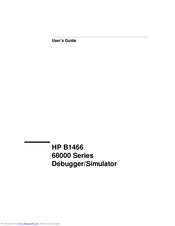HP 68000 Series Manuals
Manuals and User Guides for HP 68000 Series. We have 1 HP 68000 Series manual available for free PDF download: User Manual
HP 68000 Series User Manual (586 pages)
Debugger/Simulator
Brand: HP
|
Category: Computer Accessories
|
Size: 7.99 MB
Table of Contents
-
-
-
-
-
To Load Programs101
-
Mapping Memory127
-
-
-
Using Symbols142
-
-
To Redirect I/O191
-
-
Editing Files196
-
-
-
Using Macros209
-
To Save Macros217
-
To Load Macros217
-
To Call a Macro218
-
To Stop a Macro223
-
-
-
-
-
Part 4 Reference
281-
-
Command Summary284
-
Command285
-
File Commands285
-
Memory Commands286
-
Program Commands287
-
Symbol Commands287
-
Window Commands288
-
Breakpt Access289
-
Breakpt Delete292
-
Breakpt Erase293
-
Breakpt Instr294
-
Breakpt Read296
-
Breakpt Write297
-
Debugger Help308
-
Debugger Level309
-
Debugger Pause327
-
Debugger Quit328
-
File Command345
-
File Journal347
-
File Log349
-
File Startup351
-
File User_Fopen353
-
Memory Assign356
-
Memory Display367
-
Memory Hex369
-
Memory Map Show378
-
Memory Register386
-
Program Load401
-
Program Pc_Reset403
-
Program Run405
-
Program Step408
-
Symbol Add413
-
Symbol Browse416
-
Symbol Display417
-
Symbol Remove422
-
Window Active424
-
Window Cursor426
-
Window Delete427
-
Window Erase428
-
Window Screen_On428
-
Window New429
-
Window Resize432
-
-
-
Operators439
-
Constants441
-
Program Symbols446
-
Symbols446
-
Debugger Symbols447
-
Macro Symbols447
-
Line Numbers448
-
Reserved Symbols448
-
Address Ranges449
-
Addresses449
-
Code Addresses449
-
Keywords451
-
Storage Classes454
-
Data Types455
-
Special Casting458
-
Scoping Rules459
-
Stack References464
-
-
Break_Info469
-
Byte472
-
Close473
-
Dword474
-
Error475
-
Fgetc476
-
Fopen477
-
Getsym478
-
Inport479
-
Isalive480
-
Key_Get481
-
Key_Stat482
-
Memchr483
-
Memclr484
-
Memcpy485
-
Memset486
-
Open487
-
Outport489
-
Read490
-
Reg_Str491
-
Showversion492
-
Strcat493
-
Strchr494
-
Strcmp495
-
Strcpy496
-
Stricmp497
-
Strlen498
-
Strncmp499
-
Until500
-
When501
-
Word502
-
Write503
-
-
-
Version C.06.20526
-
Version C.05.20527
-
Version C.05.10528
-
-
-
14 Installation
533-
To Start HP VUE543
Advertisement
Advertisement
